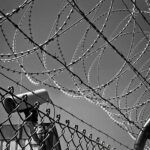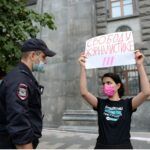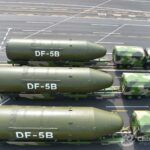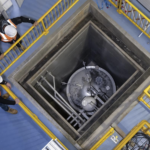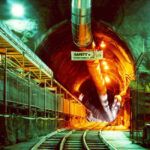Nuclear Notebook: How many nuclear weapons does North Korea have in 2022?
By Hans M. Kristensen, Matt Korda | September 8, 2022
Nuclear Notebook: How many nuclear weapons does North Korea have in 2022?
By Hans M. Kristensen, Matt Korda | September 8, 2022
Editor’s note: The Nuclear Notebook is researched and written by Hans M. Kristensen, director of the Nuclear Information Project with the Federation of American Scientists, and Matt Korda, a senior research associate with the project. The Nuclear Notebook column has been published in the Bulletin of the Atomic Scientists since 1987. This issue examines North Korea’s nuclear arsenal. The authors cautiously estimate that North Korea may have produced enough fissile material to build between 45 and 55 nuclear weapons; however, it may have only assembled 20 to 30. This article is freely available in PDF format in the Bulletin of the Atomic Scientists’ digital magazine (published by Taylor & Francis) at this link. To cite this article, please use the following citation, adapted to the appropriate citation style: Hans M. Kristensen & Matt Korda (2022) North Korean nuclear weapons, 2022, Bulletin of the Atomic Scientists, 78:5, 273-294, DOI: https://doi.org/10.1080/00963402.2022.2109341. To see all previous Nuclear Notebook columns, click here.
North Korea has made significant advances over the past two decades in developing a nuclear weapons arsenal. It has detonated six nuclear devices—one with a yield of well over 100 kilotons—and test-flown a variety of new ballistic missiles, several of which may be capable of delivering a nuclear warhead to targets in Northeast Asia and potentially in the United States and Europe. However, there is considerable uncertainty about which of North Korea’s missiles have been fielded with an active operational nuclear capability.
It is widely assumed that North Korea has operational nuclear warheads for its short-range and medium-range missiles. However, it is unclear whether it has managed to develop fully functioning nuclear warheads that can be delivered by intercontinental ballistic missiles and, following violent atmospheric re-entry, detonate as planned. That said, even though North Korea has not yet publicly demonstrated a capability to deliver a functioning nuclear re-entry vehicle on a long-range ballistic missile does not necessarily indicate that it is not working on developing one or could not field one without publicly demonstrating it. It is clear from its development efforts and public statements that North Korea ultimately intends to field an operational nuclear arsenal capable of holding regional and US targets at risk.
In 2021, Kim Jong-un announced several key strategic goals for North Korea’s nuclear weapons program, including (1) “push[ing] ahead with the production of super-sized nuclear warheads;” (2) “mak[ing] nuclear weapons smaller and lighter for more tactical uses;” (3) “raising the rate of precision good enough to strike and annihilate any strategic targets within a range of 15,000 kilometres [about 9,320 miles] with pinpoint accuracy;” (4) “develop[ing] and introduc[ing] hypersonic gliding flight warheads in a short period;” (5) “push[ing] ahead with the development of solid-fuel engine-propelled intercontinental, underwater, and ground ballistic rock- ets as scheduled;” and (6) “possess[ing] a nuclear-powered submarine and an underwater-launch nuclear strategic weapon” (Korean Central News Agency 2021).
These strategic goals were introduced in the context of a proposed five-year plan, and North Korea already appears to have made significant progress within its first year-and-a-half of implementation.
Due to the lack of clarity surrounding North Korea’s nuclear program, agencies and officials of the US intelligence community, as well as military commanders and nongovernmental experts, struggle to assess the program’s characteristics and capabilities. As a result, this paper relies upon publicly available information and satellite imagery about North Korea’s fissile material production, nuclear posture, and delivery vehicle development, and uses multiple sources of data whenever possible to corroborate conclusions. We cautiously estimate that North Korea might have produced sufficient fissile material to build 45 to 55 nuclear weapons and might have assembled 20 to 30 warheads for delivery primarily by medium-range ballistic missiles—a small increase since our last report in July 2021 (Kristensen and Korda 2021).
North Korea’s nuclear policy
For decades, North Korea has made numerous statements about its nuclear weapons policy and signals laying out its nuclear doctrine if deterrence fails. In 1997, a former North Korean official in the Ministry of Foreign Affairs testified before the US Senate that:
“as early as 1965, Kim Il-sung had said that North Korea should develop rockets and missiles to hit U.S. forces inside Japan. And regarding the U.S. forces inside South Korea [. . .] it is a well-known fact that North Korea will use short-range missiles and other missiles and rockets in order to have casualties of somewhere between 10,000 to 20,000, and even more casualties in the side of U.S. forces in order to have anti-war sentiments to rise inside the United States and cause the withdrawal of U.S. forces in the time of war” (Young-Hwan 1997).
The 2013 “Law on Consolidating the Position of Nuclear Weapons State”—one of the most recent official documents pertaining to North Korea’s nuclear doctrine—suggests a similar goal, noting that North Korea’s nuclear arsenal would only be used “to repel invasion or attack from a hostile nuclear weapons state and make retaliatory strikes” (Korean Central News Agency 2013). This doctrine would appear to bear similarities to Pakistan’s nuclear doctrine, which emphasizes using tactical nuclear weapons at the outset of a conflict to repel a superior Indian conventional invasion force (Kidwai Lt. Gen. (Ret.) Khalid 2020). More recently, North Korea’s declared aspirational development of new types of tactical nuclear delivery systems appears intended to strengthen its regional deterrence posture (National Committee on North Korea 2021; Korean Central News Agency 2022). Some experts have suggested that such a posture might involve some degree of pre-delegating nuclear launch authority down the chain of command (Narang and Panda 2017; 38 North 2022). But North Korea’s nuclear command and control system is largely unknown, and it is unclear whether North Korea’s leader, Kim Jong-un, would be comfortable with handing over control of nuclear weapons to the military.
Increased focus on tactical nuclear weapons—certainly pre-delegation of launch authority—would appear to dilute the country’s no-first-use policy, which was officially declared following North Korea’s fourth nuclear test in 2016. Since then, North Korea has added a caveat to its policy by suggesting that it would not “be the first to use nuclear weapons [. . .] as long as the hostile forces for aggression do not encroach upon its sovereignty” (Korean Central News Agency 2016a). Subsequent statements have also included such caveats; during the 75th anniversary of the ruling Korean Workers’ Party in October 2020, Kim Jong-un stated that North Korea’s nuclear deterrent “will never be used preemptively. But if, and if [sic], any forces infringe upon the security of our state and attempt to have recourse to military force against us, I will enlist all our most powerful offensive strength in advance to punish them” (38 North 2020).
Occasionally, North Korea—also known as the Democratic People’s Republic of North Korea, or DPRK—has explicitly mentioned or signaled which targets it intends to hit in the event of imminent invasion. A 2016 statement by the Supreme Command of the Korean People’s Army stated that the country would first target South Korea’s Blue House (its seat of government), then “the U.S. imperialist aggressor forces’ bases for invading the DPRK in the Asia-Pacific region and the U.S. mainland,” in that order (Korean Central News Agency 2016b). The statement does not explicitly mention nuclear use; however, it is strongly implied that nuclear weapons would be used for at least the second wave of attacks against targets related to the US/South Korea’s conventional invasion force. More recently, the January 2021 report of the 8th Congress of the Workers’ Party of Korea noted the goal of “making a preemptive and retaliatory nuclear strike by further raising the rate of precision good enough to strike and annihilate any strategic targets within a range of 15,000 kilometers [9,320 miles] with pinpoint accuracy” (National Committee on North Korea 2021). In this context, nuclear use (or the threat of nuclear use) with shorter- range missiles could potentially be used to “decouple” US military support from its regional allies in the Asia-Pacific region, by withholding strikes on US homeland targets during nuclear attacks on regional targets. Whether North Korea’s nuclear posture is advanced enough to support such a complex strategy is unknown.
At various times, North Korea has also threatened to launch nuclear weapons in response to more minor provocations, such as joint US-South Korean military exercises (Ellyatt 2016). However, despite these occasional inflammatory statements, it is highly likely that North Korea—as with other nuclear-armed states—would only use its nuclear weapons in extreme circumstances, particularly if the continued existence of the North Korean state and its political leadership were in jeopardy.
Fissile material and warhead estimates
Plutonium production
North Korea produces plutonium at its five megawatt-electric (MWe) graphite-moderated nuclear reactor, located at the Yongbyon Nuclear Scientific Research Center in North Pyongan province. Between December 2018 and July 2021, the reactor appeared to not be operational; however, in July 2021 the International Atomic Energy Agency (IAEA) noted the intermittent discharge of cooling water from the reactor and subsequent steam plumes from the reactor’s hall, signatures which would be consistent with the operation of the reactor (International Atomic Energy Agency 2021; Pabian, Town, and Liu 2021). Satellite imagery indicates that the 5 MWe reactor is likely to still be operational as of May 2022 (Makowsky, Heinonen, and Liu 2022a).
In its August 2021 annual report, the IAEA concluded that the Yongbyon complex’s thermal plant—which supplies steam to the radiochemical laboratory used for plutonium reprocessing—operated for approximately five months, from mid-February 2021 until early July 2021, after a multi-year hiatus (International Atomic Energy Agency 2021). The IAEA noted that this timeframe was consistent with the time required to reprocess a complete core of irradiated fuel. In March 2022, a United Nations Panel of Experts report noted that a “Member State assessed that the Democratic People’s Republic of Korea may have reprocessed spent fuel rods, although the Panel has been unable to verify this assessment” (United Nations 2022); additionally, as of mid-2022 independent analysts had not yet observed indications that the core had been discharged (Heinonen, Makowsky, and Liu 2022).
Since 2010, North Korea has also been in the process of constructing an experimental light water reactor and in recent years has begun transferring major reactor components into the facility at Yongbyon. The IAEA reported that North Korea may have conducted infrastructure tests of the experimental light water reactor’s cooling system throughout 2020 and 2021; however, the report noted that “it is not possible to estimate when the reactor could become operational” (International Atomic Energy Agency 2021). Independent analysts from 38 North have reported the construction of new buildings at the reactor complex throughout 2021 and 2022, including a cooling water pump house, electric switchyards, and an assortment of smaller buildings (Makowsky, Heinonen, and Liu 2022a; Heinonen, Makowsky, and Liu 2022). Although this reactor appears to be designed for civilian electricity production, it would also have a latent capacity to produce weapons-grade plutonium or tritium that could be used for North Korea’s nuclear weapons program.
In May 2022, independent analysts from the James Martin Center for Nonproliferation Studies noted the possible resumption of construction at North Korea’s long-dormant 50 MWe reactor, which had been paused since 1994. In particular, the analysts noted that North Korea appeared to be connecting the reactor’s secondary cooling loop to a pumphouse, suggesting that they planned to eventually complete the reactor (Lewis, Pollack, and Schmerler 2022). The analysts concluded that, upon completion, the reactor could theoretically produce approximately 55 kilograms of plutonium per year, enough to potentially produce about a dozen new nuclear weapons per year, depending on the design of the warhead (Lewis, Pollack, and Schmerler 2022). However, analysts from 38 North subsequently noted that similar construction efforts at the 50 MWe site are not uncommon and that the recent trenching activity could be intended to service a nearby underground facility that is unrelated to the reactor itself (Makowsky et al. 2022). Given these uncertainties, it remains unclear whether North Korea has indeed restarted construction on the 50 MWe reactor; given the state of the reactor’s apparent disrepair, doing so would likely take several years to complete (Hecker 2010).
In April 2021, former Los Alamos National Laboratory director, Siegfried Hecker, who was given unprecedented access to North Korean nuclear facilities over several years, estimated that North Korea had a plutonium inventory in the range of 25 to 48 kilograms and could produce up to six kilograms (13 pounds) per year at full operation (38 North 2021).
Uranium enrichment
It is much more difficult to assess the state of North Korea’s uranium enrichment operations because the footprint of these facilities is significantly smaller and harder to detect than plutonium production facilities.
North Korea produces yellowcake—a type of uranium concentrate powder that, once converted and enriched, is used in reactor fuel—at the Nam-chon Chemical Complex in Pyongsan (Bermudez, Cha, and Jun 2021). North Korea has only declared a single uranium enrichment facility—the Yongbyon Nuclear Fuel Rod Fabrication Plant, which is estimated to have approximately 4,000 centrifuges. This facility was in regular operation throughout 2021, as plumes of steam could be observed through satellite imagery throughout the year, in addition to the presence of what may have been a liquid nitrogen tank trailer on-site [1] (United Nations 2021a, 2022). Analysts from the James Martin Center for Nonproliferation Studies also noted in September 2021 that North Korea was expanding the size of its uranium enrichment plant to potentially accommodate approximately 1,000 additional centrifuges, which would increase the plant’s overall capacity by 25 percent (Lewis, Pollack, and Schmerler 2021).
It is widely believed that North Korea has at least one additional centrifuge facility outside of the known Yongbyon complex. In May 2018, a Washington Post article first reported the existence of a potential covert uranium enrichment site at Kangson, just outside of Pyongyang, citing work by the Institute for Science and International Security (Warrick and Mekhennet 2018). In July 2018, a team of researchers from The Diplomat and the James Martin Center for Nonproliferation Studies identified a complex at Kangson as the centrifuge facility’s suspected location (Panda 2018). A subsequent Washington Post article indicated that “there is a broad consensus among US intelligence agencies that Kangson is one of at least two secret enrichment plants” (Nakashima and Warrick 2018). In September 2020, the IAEA suggested that “[i]f the Kangson complex is a centrifuge enrichment facility this would be consistent with the agency’s assessed chronology of the development of [North Korea’s] reported uranium enrichment programme” (International Atomic Energy Agency 2020, 5). However, recent independent analysis has raised doubts about the nature of the Kangson complex, suggesting that the site might instead be used to manufacture components for centrifuges (38 North 2021; Heinonen 2020). Without more detailed public information or access to the site itself, it is not possible to confirm the nature of the Kangson site nor its potential role in North Korea’s nuclear weapons program. In 2022, the United Nations Panel of Experts listed Kangson as a “suspected clandestine uranium enrichment facility” and noted continuous vehicular and construction activities since July 2021 (United Nations 2022).
Given the uncertainties around activities at the Kangson site, it is unclear how much highly-enriched uranium (HEU) North Korea has produced; yet, this amount is known to be growing. Siegfried Hecker estimated in early 2021 that North Korea possibly had produced 600 to 950 kilograms (1,323 to 2,094 pounds) of HEU as of the end of 2020 (38 North 2021). An assessment by the Stockholm International Peace Research Institute suggests a wider range of possibly 230 to 1,180 kilograms (507 to 2,601 pounds) as of the beginning of 2021 (Kütt, Mian, and Podvig 2022, 426), whereas the International Panel on Fissile Materials estimated a slightly smaller range of 400 to 1,000 kilo- grams (882 to 2,205 pounds) in 2022 (International Panel on Fissile Materials 2022).
Warhead estimates
A common mistake in public discussions about North Korea’s nuclear capabilities is to equate the amount of fissile material produced with the number of nuclear weapons built. But, for a given amount of fissile material, the number of nuclear weapons will depend on the weapon design and the number and types of launchers that can deliver them. According to estimates, North Korea may have built several nuclear weapons that are likely smaller than its amount of fissile material suggests. This is because it is unclear whether North Korea is prioritizing the development and production of higher-yield thermonuclear weapons or lower-yield fission-only or boosted single-stage weapons. More powerful warheads with the high yield demonstrated in the single 2017 advanced design test would consume more fissile material if it is based on a composite warhead design, or would require special hydrogen fuel if it is based on a two-stage thermonuclear warhead design. Instead, lower-yield single-stage fission weapon designs would require less fissile material. Such assumptions can result in very different estimates regarding the number of nuclear weapons. One assessment in 2020 concluded that North Korea would only have 10 to 20 nuclear weapons if it had committed its fissile material to thermonuclear weapons production (Fedchenko and Kelley 2020). Another assessment concluded North Korea could produce around 40 weapons and only “very few thermonuclear bombs,” although it was unclear how many it had effectively assembled (Hecker 2020; 38 North 2021).
Based on publicly available information, we assess that North Korea has produced sufficient fissile material to build 45 to 55 nuclear weapons (if all this material is used for weapons production) but has likely assembled fewer than that—potentially 20 to 30. Per that estimate, most of the warheads would likely be single-stage fission weapons with possible yields of 10 to 20 kilotons, akin to those demonstrated in the 2013 and 2016 tests and, with only a few thermonuclear warheads. This falls within the range offered by a July 2020 US Army study, which stated that “[e]stimates for North Korean nuclear weapons range from 20–60 bombs, with the capability to produce 6 new devices each year” (US Department of the Army 2020). It also falls within the range offered in October 2018 by South Korea’s then-Unification Minister, who disclosed to the parliament a South Korean intelligence assessment that North Korea’s nuclear arsenal contained between 20 and 60 weapons (Kim 2018).
Assumptions about fissile material production and warhead designs also affect projections for how many nuclear weapons North Korea might have in the future—and tend to result in inflated numbers. For example, a 2021 study assumed North Korea might already have 67 to 116 nuclear weapons and projected the inventory might reach 151 to 242 nuclear weapons by 2027 (Bennett et al. 2021). Others found the projection to be “much too high” (38 North 2021). It seems more plausible that North Korea might be capable of adding sufficient fissile material for a few to half a dozen nuclear warheads per year, which would potentially be sufficient to produce a total of approximately 80 to 90 weapons by the end of the decade.
Nuclear testing and warhead capabilities
After six nuclear tests—including two with moderate yields and one with a high yield—there is no longer any doubt that North Korea can build powerful nuclear explosive devices designed for different yields. North Korea has even published pictures of what it claims to be different warhead designs (including a “thermonuclear” design) that appear small and light enough to potentially be delivered by ballistic missiles (see Figure 1 below). The published designs might be real warheads, prototypes, or models. There is no way to know for sure. Nor is it known if the published designs match the devices detonated in the nuclear explosive tests.

Milestones and assessments
Although North Korea is widely assumed to have developed warheads for its short-range and medium-range ballistic missiles, there is less agreement about its ability to deliver functioning nuclear warheads with long-range intercontinental missiles. These uncertainties are often overlooked in the public debate about North Korea’s nuclear capabilities. [2] To better understand the status of North Korea’s nuclear weapons program and assessments about its warheads, it is useful to review the major milestones and assessments from the last two decades or so.
North Korea apparently began developing nuclear weapons even before the formal collapse of the Agreed Framework—a 1994 arrangement whereby the United States would provide Pyongyang with two proliferation- resistant nuclear power reactors and, in turn, North Korea would freeze operations at reactors thought to be part of a nuclear weapons program. As publicly reported in 2004, Pakistani nuclear physicist Abdul Qadeer Khan said that sometime around 1999 he was shown “three plutonium devices” during a visit to an underground facility about one hour outside Pyongyang (Sanger 2004). [3] Three years later, then-US Secretary of State Colin Powell publicly stated of North Korea: “We now believe they have a couple of nuclear weapons and have had them for years” (US State Department 2002).
The “weapons” to which Powell referred might have been the “devices” Khan saw or early prototype designs intended to be used in nuclear tests if necessary. But only three years after Powell’s statement, in December 2005, North Korea itself for the first time declared that it had “manufactured nukes for self- defense” and that the weapons “will remain [a] nuclear deterrent for self-defense under any circumstances” (Washington Post 2005).
Less than a year later, on October 9, 2006, North Korea conducted its first nuclear test. The explosive yield was limited, less than one kiloton—not an impressive demonstration of a nuclear weapons capability and widely seen as a fizzle. The US intelligence community stated that the test produced a yield of “less than one kiloton—well below the yield of other states’ first nuclear test” (Office of the Director of National Intelligence 2007).
The second test—two-and-a-half years later, on May 25, 2009—was a little more powerful and “suggests the North has the capability to produce nuclear weapons with a yield of roughly a couple kilotons TNT equivalent,” according to the US intelligence community.
These tests did not demonstrate the yield needed for operational nuclear weapons. A RAND Corporation report in 2012 cautioned: “It should also be considered that even speculative sources estimate that North Korea cannot have more than a few nuclear weapons available. If they exist, these devices are very precious to the regime, and it seems unlikely that they would be mounted on inaccurate and unreliable missile systems—the risk of ‘losing’ a weapon is simply too high” (Schiller 2012).
The third test, conducted on February 12, 2013, was more convincing. The intelligence community initially said that its yield was “several kilotons”—but international analysis subsequently estimated the yield to have been around 10 kilotons (Office of the Director of National Intelligence 2013; NORSAR 2017). This prompted some experts to suggest that North Korea might have developed a miniaturized warhead for the Nodong missile, though others thought it was too soon for North Korea to have accomplished that feat (Albright 2013; J. Kim 2014; McGrath and Wertz 2015).
Around the same time, the US Defense Intelligence Agency—in an assessment distributed to members of the US Congress—for the first time concluded: “[The Defense Intelligence Agency] assesses with moderate confidence [that] the North currently has nuclear weapons capable of delivery by ballistic missiles; however the reliability will be low” (Shanker, Sanger, and Schmitt 2013). The assessment did not reflect the conclusion of the US intelligence community as a whole and triggered an immediate rebuttal by the US Defense Department: “It would be inaccurate to suggest that the North Korean regime has fully developed and tested the kinds of nuclear weapons referenced in the passage.” The Director of National Intelligence added that “the statement read by the member is not an intelligence community assessment” and that “North Korea has not yet demonstrated the full range of capabilities necessary for a nuclear-armed missile” (Clapper 2013).
Similarly, the US Air Force Global Strike Command stated in a briefing in September 2013 that North Korea “currently does not have an operational warhead; if developed, it could be deployed on” the Musudan (Hwasong-10), Taepo Dong-2, or Hwasong-13 (US Air Force Global Strike Command 2013).[4] Global Strike Command did not list any medium- or short-range missiles with nuclear capability.
Even so, the assessment among independent analysts at the time was that medium- and possibly short-range ballistic missiles were the first platforms for North Korean nuclear weapons. An April 2015 report from the US-Korea Institute at the Johns Hopkins School of Advanced International Studies, for example, claimed that the Nodong missile formed “the backbone of its current deterrent . . . ” (Schilling and Kan 2015). Similarly, after North Korea’s fifth nuclear test, in September 2016, demonstrated a yield of 10 to 15 kilotons, the Institute for Science and International Security estimated that “North Korea may have a handful of plutonium-based warheads for its Nodong ballistic missile” (Albright 2017).
But military commanders also appeared to go further than the intelligence community at the time. The commander of US Forces Korea, Gen. Curtis Scaparrotti, stated in October 2014: “I believe they have the capability to miniaturize a device at this point and they have the technology to potentially deliver what they say they have.” Scaparrotti cautioned: “We’ve not seen it tested,” but added: “I don’t think as a commander we can afford the luxury of believing perhaps they haven’t gotten there.” The Pentagon press secretary clarified: “General Scaparrotti said he believes they have the capability to miniaturize. That’s not the same thing as saying that they have the capability to mount, test, and deliver a nuclear weapon in an [intercontinental ballistic missile]” (Alexander and Stewart 2014).
The South Korean Ministry of Defense also did not agree with Scaparrotti’s assessment. “Despite its significant technology level, we don’t think the North is capable of making such nuclear weapons,” a spokesperson said in February 2015 (Korea Herald 2015a).
As these quotations suggest, there was confusion about how to describe North Korea’s nuclear capabilities at the time. On March 20, 2015, the Korea Herald quoted Admiral Cecil Haney, then the commander of US Strategic Command, saying about North Korea’s nuclear capability: “We think they already miniaturized some of this capability” (Korea Herald 2015b). But when asked at a press conference only four days later if North Korea had a miniaturized warhead that it could put on a missile, Haney said: “As of yet, I don’t see any tests yet that [were] associated with this miniaturized claim” (US Defense Department 2015a).
Additionally, when Admiral Bill Gortney, then-commander of the North American Aerospace Defense Command and US Northern Command, was asked in April 2015 if he thought North Korea had “developed the capability to miniaturize a nuclear warhead and put it on a ballistic missile like the KN08,” he responded that “we assess that they have the ability to do that” (US Defense Department 2015b).
At the time, however, North Korea had not even test-launched the KN08, so Gortney cautioned: “Now, we have not seen them do that. We haven’t seen them test that.” Yet he added: “I don’t think the American people want us to—you know, there are some things that they want us to make sure we edge on the side of conservatism to make sure we get right” (US Defense Department 2015b).
The explanation was an important reminder to be cautious when interpreting official statements about North Korean nuclear capabilities. “Our assessment,” Gortney said, “is that they have the ability to put it on a nuclear weapon on a KN08 and shoot it at the homeland. And that—that’s the way we—that’s the way we think. That’s our assessment of the process (emphasis added).
We haven’t seen them test the KN08 yet and we’re waiting to do that. But it doesn’t necessarily mean that they will fly before they test it” (US Defense Department 2015b).
After its fourth nuclear test, on January 6, 2016, North Korea claimed it had successfully detonated what it described as a “hydrogen” bomb. The yield of the explosion was relatively modest (around five kilotons), and the US intelligence community assessed the following month that “the low yield of the test is not consistent with a successful test of a thermonuclear device” (Clapper 2016). A second test that year, on September 9, was more powerful (10 to 15 kilotons) but still far from what one would expect from a successful thermonuclear test. [5] It is possible, but unknown, that the North Korean reference to a so-called “hydrogen” bomb implied the use of tritium to boost the efficiency of a single-stage fission device. Such a technology would enable North Korea to use less fissile material in each bomb and further expand its production capacity (Jones 2016).
Additionally, it is unclear if the tests involved actual nuclear warhead designs or test devices that would require further modification to be fitted on a missile. Dennis Blair, who was Director of National Intelligence from 2009–2010 and a former commander of US Pacific Command, as late as April 2017 seemed to think that the explosions involved test devices rather than proof tests of operational designs. During a talk, Blair characterized North Korea’s nuclear warheads as “these crude weapons that they developed maybe seven or eight years ago,” each of which “is about the size of half of this stage . . . ” Pyongyang’s program, Blair asserted, “may be developing 10 to 15 nukes” (Blair 2017). Whether Blair was aware of later designs is not clear, but his description is a far cry from the pictures released by North Korea at the time, whether legitimate or not, that showed the so-called “disco ball” and “peanut” warhead designs.
In early August 2017, Gen. Paul Selva—then vice-chairman of the Joint Chiefs of Staff—gave a detailed account of the uncertainties that remain about North Korea’s nuclear capabilities (Garamone 2017). “Before we can assert Kim Jong-unhas a nuclear missile capable of targeting the United States,” Selva said, “there are a couple of aspects we must know.” He listed several criteria that must be met (Selva 2017):
- “One, [Kim] has to have the missile that will actually range that distance. We believe he has that capability right now. It’s clear that he can build a rocket that can fly that far.
- [Two,] [h]e’ll have to have the guidance and control system, the guidance and stability control, to move a rocket across that distance without it breaking up. We don’t know if he has that. We don’t know that he doesn’t. He’s been pretty successful at short- and medium-range ballistic missiles. But the physics of a long-range missile are substantially different. So stability control matters. And that’s a gap we need to fill in our understanding of whether or not he can do this.
- The third piece is a re-entry vehicle that can survive the stresses of an intercontinental ballistic missile shot. Once again, much easier to go straight up and down than it is to endure the re-entry stresses and the actual heat of an intercontinental missile shot. We don’t know if he’s got that technology. We don’t know that he doesn’t, but we don’t know that he does. He hasn’t demonstrated it. We have to see.
- And the last is a nuclear weapon that can survive that trip. Again, that’s what we don’t know. We don’t know the design specifics of his nuclear weapons—purported nuclear weapons. We don’t know if he’s been able to miniaturize it and make it stable enough.”
One month later, on September 3¸ 2017, North Korea demonstrated clearly that it could potentially produce nuclear devices with yields in the range of thermonuclear warheads. A nuclear explosion with a yield of well over 100 kilotons showed that North Korea had managed to design a thermonuclear device or one that used a mixed-fuel (composite) design. The US intelligence community reportedly called it an “advanced nuclear device” (Panda 2017b). Yield estimates range from 140 to 250 kilotons (Asia Review 2017; NORSAR 2017).
Despite the uncertainty about the number and ability to deliver a functioning nuclear warhead to the United States, some experts at the time asserted that North Korea could do just that. Yet even after several intercontinental ballistic missile (ICBM) flight tests conducted by North Korea in 2017, the chairman of the Joint Chiefs of Staff, Gen. Joseph Dunford, stated in 2019 that North Korea had not yet demonstrated the capability to deliver a functioning nuclear warhead on a long-range missile: “I still see a potential although as-yet-undemonstrated capability to match a nuclear weapon with an intercontinental ballistic missile . . . ” (Dunford 2019). The UN Panel of Experts reported in 2021 that an anonymous member state had assessed, “judging by the size of the missiles of the Democratic People’s Republic of Korea, that it is highly likely that a nuclear device can be mounted on the intercontinental ballistic missiles, and it is also likely that a nuclear device can be mounted on the medium-range ballistic missiles and short-range ballistic missiles.” But because the size of a missile does not in and of itself reveal anything about the capability of the nuclear device it may be capable of carrying, the member state cautioned that “it was uncertain whether the Democratic People’s Republic of Korea had developed ballistic missiles resistant to the heat generated during reentry” (United Nations 2021b).
In sum, these assessments indicate that although North Korea has developed nuclear devices small enough to be mounted on its medium- and long-range ballistic missiles, it is unclear whether it has developed a re-entry vehicle capable of protecting a device during re-entry through the Earth’s atmosphere.
Latest nuclear testing activities
North Korea has conducted all its nuclear tests at the Punggye-ri test site in North Hamgyong province, which consists of a large mountain complex with several underground tunnels. North Korea partially disabled the complex in May 2018 by destroying three tunnel entrances and several nearby buildings; this was done as a confidence-building measure in advance of a planned meeting between Kim Jong-un and Donald Trump (Talmadge 2018). However, the underground site itself was not destroyed and could therefore be reconstituted if necessary.
In early 2022, after an extended period of inactivity, North Korea began to reconstitute the Punggye-ri site. Satellite images collected between March and June 2022 revealed the construction of new buildings and renovation of older ones; movement of lumber, equipment, and personnel; new excavation activity; and the creation of a new portal into the mountain test site (Makowsky, Heinonen, and Liu 2022b; Bermudez, Cha, and Jun 2022; Lewis and Schmerler 2022). This substantial new construction effort suggests that North Korea may be preparing for another underground nuclear test, and both US and South Korean officials have stated that they expect a seventh test to be conducted soon (Kang 2022; BBC 2022). In August 2022, the UN Panel of Experts reported that North Korea had tested ”nuclear triggering devices” in June; however, the panel was ”unable to identify the test locations and dates” associated with the tests. The Panel additionally noted that ”[a]s of early June, two member states assessed that the preparation for nuclear tests was at a final stage” (Lederer 2022).
Land-based ballistic missiles
Over the past decade, North Korea has developed a highly diverse ballistic missile force, including missiles in all major range categories. In addition to the afore-mentioned uncertainties surrounding North Korea’s nuclear warheads, it is unclear how many operational delivery vehicles North Korea possesses and which of those would be assigned a nuclear mission. It is also important to note that some of the ballistic missile types North Korea has flight-tested or displayed might be research projects intended to develop future ballistic missile technology, rather than demonstrations of operational missiles.
In recent years, a wealth of new information about North Korean missile bases has become publicly available, most prominently thanks to the work of Joseph Bermudez Jr. and Victor Cha on the Beyond Parallel website (Beyond Parallel 2022). Despite North Korea’s missile development and extensive construction at suspected missile bases, however, the operational status of many of these missiles remains uncertain. The Missile Defense Review report published by the Pentagon in 2019, for example, stated that none of North Korea’s modern longer-range missiles had been fielded (US Defense Department 2019). However, North Korea has dramatically escalated its missile testing in recent years: the UN Panel of Experts reported that as of August 2022, the country had already tested 31 missiles, compared to the 25 it tested throughout the entirety of 2019, its last record-breaking year (Lederer 2022).
To ensure completeness, this section analyzes all of North Korea’s known land-based ballistic missiles (see Table 1) and offers some hypotheses about which missiles are most likely to have a nuclear role. Again, the inclusion of a missile in the table does not necessarily mean it is known or certain to have a nuclear role.
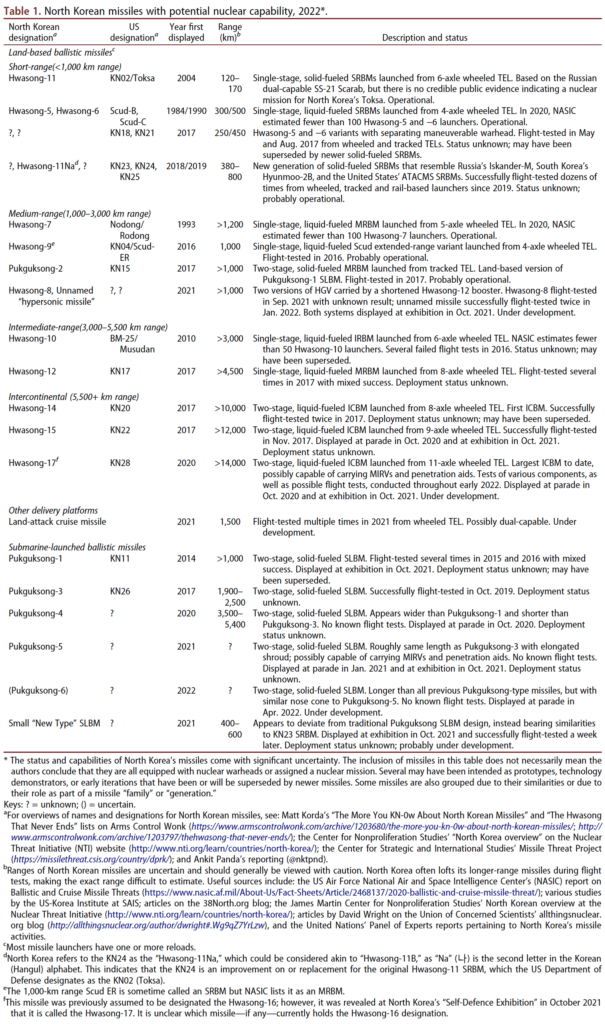
North Korea possesses several distinct types of short-range ballistic missiles (SRBMs), although many are part of the same missile “family” and therefore share common designs and characteristics.
In a May 2021 speech, Kim Jong-un stated that North Korea had developed what he described as “tactical nuclear weapons including new-type tactical rockets . . . ” In the future, he stated, it would be necessary to improve the technology “and make nuclear weapons smaller and lighter for more tactical uses. This will make it possible to develop tactical nuclear weapons to be used as various means according to the purposes of operational duty and targets of strike in modern warfare . . . ” (North Korean Ministry of Foreign Affairs 2021). The meaning of “tactical,” however, is not clear. It could mean actual short-range tactical nuclear weapons or simply weapons that have a shorter range than intercontinental weapons.
North Korea operates several Toksa (KN02) solid-fueled ballistic missiles with a maximum range of 120 kilometers (75 miles), and potentially an extended-range version with a maximum range of 170 kilometers (106 miles) (E. Kim 2014). This missile is based on the Russian Tochka (SS-21 Scarab), which was developed as a dual-capable missile. However, there is no credible public evidence that suggests North Korea has developed a nuclear capability for the Toksa.
North Korea operates several distinct types of liquid-fueled missiles belonging to the Scud missile family. The Hwasong-5 and Hwasong-6 SRBMs are the North Korean versions of Russian-built Scud B and Scud C missiles, respectively. The US Air Force’s National Air and Space Intelligence Center lists the missiles’ ranges at 300 and 500 kilometers (186 and 311 miles), respectively, and estimates that North Korea has fewer than 100 launchers for the combined Hwasong-5 and -6 arsenal (National Air and Space Intelligence Center 2020, 21).
North Korea is modernizing both types of missiles by equipping them with maneuverable re-entry vehicles designed to evade regional missile defense systems like the Terminal High Altitude Area Defense (THAAD) system, which the United States deploys in South Korea (Panda 2017e). The modernized Hwasong-5, which has been designated KN21 by the US government, was flight-tested three times in August 2017, with one failure (James Martin Center for Nonproliferation Studies 2022). The modernized Hwasong-6, which has been designated KN18, was successfully flight-tested in November 2017 (James Martin Center for Nonproliferation Studies 2022).
In recent years, North Korea has been developing a new series of more accurate, solid-fueled SRBMs with indigenous designs. These missiles, which are known as the KN23, KN24, and KN25, have collectively been tested more than 40 times since the beginning of 2019 (James Martin Center for Nonproliferation Studies 2022). These missiles appear to bear several similarities to conventional American, South Korean, and Russian missiles, such as the ATACMS, Hyunmoo-2B, or Iskander SRBMs, and North Korea has stated that certain variants of these new missiles can carry 2.5-ton warheads. This is a much heavier payload than would be needed for carrying a nuclear weapon and could therefore indicate a conventional role (Voice of Korea 2021a). It is possible, however, that one or more of these new solid-fuel missiles could eventually be operationalized to deliver nuclear weapons.
Some of these SRBMs, including the KN23 and possibly the KN24, can conduct “pull-up” maneuvers in their terminal phase of flight, thus complicating the abilities of North Korean adversaries to track the missiles during their descent.
In September 2021, North Korea launched two KN23 SRBMs, but for the first time, they were launched from a rail-mobile launcher. Following the successful test, North Korea announced its intention to expand the Railway Mobile Missile Regiment—created at the Eighth Congress of the Workers’ Party of Korea (WPK) in January 2021—into a brigade, which could eventually consist of nine launchers with 18 missiles (Voice of Korea 2021b). North Korea tested two other KN23 SRBMs from rail-mobile launchers in January 2022 (Voice of Korea 2022a). Given that North Korea has an extensive cross-country rail network that frequently travels through mountains, rail-mobile launchers would enable North Korea to move missiles around the country rapidly and increase the survivability of its second-strike force.
North Korea appears to be continuously iterating on these indigenous missile designs. In April 2022, Kim Jong-un oversaw a test of a “new-type tactical guided weapon,” which was explicitly linked to North Korea’s nuclear program. Not only was this test launch characterized as one of the “pivotal goals for war deterrent advanced at the Eighth Congress of WPK”—which specifically included developing tactical nuclear delivery systems—but the accompanying press release noted that this new missile would “[strengthen] the effectiveness of tactical nuclear operation of [North Korea]” (Voice of Korea 2022b).
The sophisticated testing program for these newer systems indicates that North Korean missile troops are becoming significantly more practiced at conducting salvo launches and lowering the time intervals between missile launches (Dempsey 2020). As an illustration of this new capability, in June 2022, North Korea test-launched eight SRBMs from multiple different locations in less than an hour. This constituted the largest number of North Korean ballistic missiles launched on a single occasion (Yonhap News Agency 2022a).
Medium-range missiles
North Korea has likely operationalized three medium- range ballistic missiles (MRBMs), with several more in development. This is the category of missile that is most likely to have an operational nuclear capability.
The Hwasong-9 (Scud-ER) is a single-stage, liquid-fuel, road-mobile, medium-range ballistic missile launched from a four-axle transporter erector launcher. This launcher is very similar to the one used with Scud B and Scud C short-range ballistic missiles. Many sources consider the Scud-ER a short-range ballistic missile, but in a triple test launch on September 5, 2016, the missiles apparently flew to a range of 1,000 kilometers (621 miles), the lower end of the range that the National Air and Space Intelligence Center uses for medium-range ballistic missiles (National Air and Space Intelligence Center 2020, 25).
The Hwasong-7 (Nodong/Rodong) is a single-stage, liquid-fuel, medium-range ballistic missile carried on a five-axle road-mobile transporter erector launcher. The missile, which was first test-flown in 1993, exists in two versions (Mod 1 and Mod 2) and has an estimated range of 1,200 kilometers (746 miles) or more. The National Air and Space Intelligence Center estimates that North Korea deploys fewer than 100 Hwasong-7 launchers (National Air and Space Intelligence Center 2020, 25). Apparently, the Nodong was originally intended to carry a first-generation nuclear warhead, and US naval intelligence reportedly warned in 1994 that North Korea would probably be able to equip the missile with a nuclear warhead by 2000, and possibly earlier (Bermudez 1999; Pinkston 2008). The Nodong’s accuracy is poor relative to North Korea’s more modern missiles, and its conventional utility is therefore quite limited. Partially for this reason, some analysts have suggested that the Hwasong-7 is one of the most likely missiles to have an operational nuclear capability (Albright 2013; James Martin Center for Nonproliferation Studies 2006; Center for Strategic and International Studies 2021).
The Pukguksong-2 (KN15)—sometimes spelled “Pukkuksong-2” or “Bukkeukseong-2” (“Polaris- 2”)—is a two-stage, solid-fuel, medium-range ballistic missile carried in a canister on a road-mobile caterpillar-type transporter erector launcher. The missile was first test-launched in 2017 and appears to be a modification of the submarine-launched Pukguksong-1 (Polaris-1). It is North Korea’s first attempt to field a solid-fuel, land-based ballistic missile. The first two flight tests in 2017 demonstrated a range of up to 1,200 kilometers (746 miles), which fits the National Air and Space Intelligence Center’s range estimate of 1,000 kilometers (621 miles) or more (Wright 2017a, 2017c). Compared to liquid-fueled missiles, solid-fueled missiles require less logistical support and require much less preparation time before launch.
The Hwasong-8 is a new missile first revealed in 2021. The missile appears to be composed of a modified Hwasong-12 booster and can carry multiple different payloads, including a hypersonic glide vehicle (HGV) and a maneuverable re-entry vehicle (MaRV). The Hwasong-8 variant carrying an HGV was tested in September 2021, and the variant carrying a MaRV was tested twice in February 2022. During the second test in February, North Korea claimed that the missile conducted a “corkscrew” maneuver, which reportedly prompted the US Federal Aviation Administration to temporarily pause commercial airline departures along the west coast of the United States for approximately 15 minutes (Chongnyon 2022; Liebermann, Muntean, and Starr 2022).
The Hwasong-8 was displayed at North Korea’s “Self- Defence 2021” exhibition in October 2021, alongside another unnamed missile—also using a modified Hwasong-12 booster—described as “hypersonic” by the North Korean state media. Independent analysis suggests that although the boosters are very similar, the hypersonic glide vehicles used on the Hwasong-8 and the unnamed missile are of a different design (Xu 2022a).
North Korean state media reported that the Hwasong-8 was the first North Korean missile to use a “fuel ampoule,” which involves placing pre-fueled, liquid-fueled missiles in temperature-controlled canisters to facilitate faster launches (DPRK Today 2021; Xu 2021). North Korea says it plans to transition all liquid-fueled missiles into ampoules (DPRK Today 2021).
Intermediate-range ballistic missiles
The Hwasong-10 (Musudan) is a single-stage, liquid-fuel, intermediate-range ballistic missile launched from a six-axle transporter erector launcher. The missile, which is also sometimes designated BM-25, has an estimated range of more than 3,000 kilometers (1,864 miles), but it suffered several test failures in 2016 (James Martin Center for Nonproliferation Studies 2022). The National Air and Space Intelligence Center estimated in 2020 that North Korea had fewer than 50 Hwasong-10 launchers (National Air and Space Intelligence Center 2020, 25). However, given the system’s unreliability, the overall status of the Hwasong-10 program remains unclear; it may have been replaced by the newer Hwasong-12 as North Korea’s primary intermediate-range ballistic missile.
The Hwasong-12 (KN17) is a single-stage, liquid-fuel, intermediate-range ballistic missile carried on an eight-axle road-mobile transporter erector with a detachable firing table. After several failures, the missile was test-launched on a highly lofted trajectory on May 14, 2017, reportedly demonstrating that it could travel approximately 4,500 kilometers (2,796 miles) if flown on a normal trajectory (Wright 2017b). The National Air and Space Intelligence Center estimates the range as 3,000 kilometers (1,864 miles) or more. A subsequent test, on August 28, overflew Japan before it crashed in the western Pacific, some 2,700 kilometers (1,678 miles) from the launch site. A third successful launch, on September 14, demonstrated a longer range—approximately 3,700 kilometers (2,299 miles) (Panda 2017c; Wright 2017f). In January 2022, North Korea launched its first Hwasong-12 in nearly five years, demonstrating a similar trajectory to its previous launches (Japanese Ministry of Defence 2022a). At this stage, it is unknown if the Hwasong-12 has been deployed.
Intercontinental ballistic missiles
The most dramatic of North Korea’s recent developments has been the display and test launch of large ballistic missiles that appear to have an intercontinental range. North Korea has publicly shown five types of missiles in this range category: the Taepo Dong-2, the Hwasong-13, the Hwasong-14, the Hwasong-15, and the Hwasong-17. These systems are in various stages of development, and some may simply be mockups or technology demonstrators.
The Taepo Dong-2 is a three-stage, liquid-fuel, long-range missile that is thought to be a derivative of the Unha-3 space-launch vehicle. The Unha-3 placed a satellite in an unstable orbit in 2016. North Korea has not yet demonstrated a functioning re-entry vehicle for the Taepo Dong-2, and the National Air and Space Intelligence Center’s 2020 annual report lists the system as a “space launch vehicle” (National Air and Space Intelligence Center 2020, 29). Given North Korea’s recent development of newer, more sophisticated long-range systems, we assess that the Taepo Dong-2 is not currently an operational military system and will not be a focus for North Korea’s ICBM program moving forward.
The Hwasong-13 (KN08) is a three-stage, liquid-fuel intercontinental ballistic missile (ICBM) carried on an eight-axle transporter erector launcher (TEL) that uses a truck like the one used for the Hwasong-14 ICBM. The Hwasong-13 was first displayed during a parade in 2012. In 2013, a US Air Force Global Strike Command briefing listed the KN08 as an ICBM that “could field in [the] next [five] years” (US Air Force Global Strike Command 2013). However, the Hwasong-13 has not been flight-tested, and given North Korea’s recent development of newer, more sophisticated long-range systems, we assess that the Hwasong-13 is not currently an operational system and, like the Taepo Dong-2, will not be a focus for North Korea’s ICBM program moving forward.
In July 2017, North Korea conducted its two, first-ever, test-launches of the Hwasong-14 (KN20) ICBM. The two-stage, liquid-fueled Hwasong-14 appears to share its first stage with the Hwasong-12 intermediate-range ballistic missile and is launched from an eight-axle road-mobile transporter erector with a detachable firing table.
The first test launch took place on July 4 and the missile flew on a highly lofted trajectory to 950 kilometers (590 miles). An unnamed US government source later told The Diplomat that the United States assessed the range to be 7,500 to 9,500 kilometers (4,660 to 5,903 miles) on a normal trajectory (Panda 2017a). North Korea released a video of the launch that showed the missile had a modified payload shroud, which looked like a shroud that appeared in photos of Kim Jong-un, engineers, and a peanut-shaped device said to be a thermonuclear warhead. North Korea claimed that the test demonstrated that it could use a re-entry vehicle to protect the missile’s warhead, but that was later shown to be inaccurate (Wright 2017d).
The second Hwasong-14 test launch, conducted on July 28, also used a lofted trajectory and reached an apogee of roughly 3,700 kilometers (2,299 miles). According to the National Air and Space Intelligence Center and some independent analysts, the test demonstrated that the missile could, if flown on a normal trajectory, have a range of over 10,000 kilometers (6,214 miles) (Wright 2017e; National Air and Space Intelligence Center 2020, 27). This would potentially bring US cities on the west coast, including Los Angeles and Seattle, within striking range (Elleman 2018). The weight of the payload used in the test, which could significantly affect the range, is not known; however, a subsequent analysis suggests that the test was likely not conducted using a re-entry vehicle with a realistically heavy mock warhead (Acton, Lewis, and Wright 2018). Therefore, the test did not demonstrate whether North Korea has a functioning ICBM re-entry vehicle to protect a warhead. Notably, North Korea did not display the Hwasong-14 at its most recent military parade that featured ICBMs, in October 2020; this could indicate that North Korea intends to put more emphasis on its newer, longer-range ICBMs (NK News 2020).
During a parade in October 2017, North Korea also displayed two new launchers with large canisters for the transport of missiles. One launcher appeared similar to the eight-axle transporter erector used for the Hwasong-14 but modified with a large canister that resembled the missile canister used on the Russian SS-25 (Topol) transporter erector launcher. The second new launcher equipped with a missile canister strongly resembled the transporter erector launcher used for the Chinese DF- 31A. Canister launchers are normally used to transport solid-fueled missiles, so the two new launchers—coupled with Kim Jong-un’s recent statements—suggest that North Korea is trying to develop a solid-fueled ICBM.
After a two-month pause in missile flight tests, on November 29, 2017, North Korea launched a newer ICBM with an even longer range: the Hwasong-15 (KN22). The two-stage, liquid-fuel missile was launched from a nine-axle transporter erector on a highly lofted trajectory to nearly 4,500 kilometers (2,796 miles), which indicates a maximum range on a normal trajectory with a light payload of approximately 13,000 kilometers (8,078 miles), sufficient to potentially target most of the United States (Wright 2017g). The National Air and Space Intelligence Center lists the range of the Hwasong-15 to be upwards of 12,000 kilometers, or 7,456 miles (National Air and Space Intelligence Center 2020, 29). However, it is important to note that heavier payloads—including nuclear warheads—would significantly decrease the missile’s range. Hwasong-15 ICBMs were displayed during North Korea’s October 2020 military parade (NK News 2020).
In April 2018, Kim Jong-un announced that North Korea would observe a self-imposed moratorium on nuclear explosive tests and flight tests of long-range ballistic missiles (Korean Central News Agency 2018). In January 2020, North Korean diplomats announced that the country would no longer observe the moratorium, yet North Korea did not test-launch another ICBM until 2022 when it conducted several tests of ICBMs and ICBM components throughout the year (Nebehay 2020).
On February 26 and March 4, 2022, North Korea conducted successful missile launches that appeared to be of medium range; but on March 10 the Pentagon announced it believed the tests were related to North Korea’s ICBM program (Hadley 2022). Given this announcement, coupled with the specific subsystems mentioned in North Korea’s press releases about the tests, it is possible that the tests were related to the development of a multiple independently targetable re- entry vehicle (MIRV) bus (James Martin Center for Nonproliferation Studies 2022).
On March 24, North Korea claimed to have test-launched its new liquid-fueled Hwasong-17 ICBM for the first time. This missile had first been unveiled at North Korea’s October 2020 military parade (see figure at top of page), during which independent analysts noted the missile was significantly larger than other North Korean ICBMs, and that the missile’s diameter could range between 2.4 and 2.5 meters (roughly about 7.8 feet to 8 feet), with a length of roughly 24 to 25 meters (about 78.75 to 82 feet) (Lewis 2020; La Boon 2020; Elleman 2020). During the March 24 flight test, the missile reached an apogee of nearly 6,200 kilometers (3,853 miles) and traveled nearly 1,100 kilometers (683 miles) over the course of 71 minutes—suggesting a possible range of approximately 15,000 kilometers (9,321 miles) (Yonhap News Agency 2022b). However, an NK News analysis of the launch video released by North Korea suggests that the missile may have been tested on March 16 but failed and that the missile tested on March 24 may have been a Hwasong-15 instead (Zwirko 2022).
On May 4 and May 24, North Korea conducted two additional tests of what may have been ICBM components—like the tests of February 26 and March 4—or possibly, according to the US government, failed Hwasong-17 tests (Starr and Herb 2022; Starr 2022).
If deployed, it is estimated that the Hwasong-17 could potentially deliver a large warhead—or hypothetically a small number of multiple re-entry vehicles or a single re-entry vehicle with penetration aids—to the continental United States. However, these advanced capabilities would require a sophisticated testing campaign that would take several years to complete (Elleman 2020).
Overall, despite North Korea’s considerable advancements in its ICBM program, the country has still not publicly demonstrated an operationally functioning re-entry vehicle that can protect a warhead during re-entry through the Earth’s atmosphere. Moreover, there is still considerable uncertainty about how the combination of the missile, re-entry vehicle, and warhead would function in a real attack.
After the July 2017 test of an Hwasong-14 ICBM, the US Central Intelligence Agency (CIA) reportedly concluded that the re-entry vehicle did not survive re-entry but would nonetheless likely work in an attack on the United States (Panda 2017d). Yet after the test flight of the Hwasong-15 ICBM, on November 28, a US official told CNN that “the North Koreans had problems with reentry” and that the missile likely broke up upon re-entry into Earth’s atmosphere (Starr and Sanchez 2017). The South Korean deputy minister of defense policy, Yeo Suk-joo, reportedly told the South Korean parliament that North Korea still needed to proof-test some technologies, like re-entry, terminal stage guidance, and warhead activation (Kim and Solovyov 2017). Seoul’s Foreign Minister Kang Kyung-wha added that North Koreans “haven’t demonstrated their reentry capability. They haven’t demonstrated their remote targeting, or the miniaturization that is required to do this” (Krever 2017). These statements match the assessments listed above from US officials.
Union of Concerned Scientists’ expert David Wright agreed that “North Korea has not yet demonstrated a working reentry vehicle on a trajectory that its missiles would fly if used against the United States,” but added that there did not appear to be a technical barrier to building a working re-entry vehicle (Wright 2017h). In 2017, Stanford’s Siegfried Hecker estimated that this might take another two years of tests (Hecker 2017).
North Korea’s ability to deploy large numbers of heavy long-range missiles could depend on its ability to procure or indigenously produce launchers for those missiles. In the past, North Korea has sourced its heavy launchers from Russian, Belarusian, and Chinese companies, and imported them under the guise of civilian applications (Hanham 2012; Schiller 2012). For example, North Korea purchased at least six eight-axle Chinese WS51200 vehicles—which had been marketed as lumber haulers—with the intended end-user designated as the North Korean Ministry of Forestry. Converted WS51200 vehicles were, however, subsequently displayed at an April 2012 military parade carrying Hwasong-13 ICBMs, and they have appeared at several subsequent military parades and during missile test launches (United Nations 2021b, Annex 10, 2013). It also appears that at least one of these vehicles was indigenously modified to add a ninth axle to support the November 2017 launch of the Hwasong-15 ICBM (United Nations 2021b, Annex 10).
No more than six converted WS51200 launchers have appeared at any one time, so it is possible that North Korea only maintains a total of six such launchers. Given the rigid sanctions regime under which the country operates, it is exceedingly difficult for North Korea to import additional launchers; as such, it is clear that North Korea is working toward developing an indigenous heavy launcher production capability.
In late 2017 and early 2018, Kim Jong-un visited several factories with ties to the “production of Korean- style heavy-duty vehicles,” according to North Korean state media, including the March 16 Factory, the Kumsong Tractor Factory, the Amnokgang Tire Factory, the Sungri Motor Complex, and the Pyongyang Trolley Bus Factory (Panda 2018). Indigenously producing heavy launchers is a highly challenging prospect, however. The chassis and steering systems are complicated to produce and North Korea would also have to develop powerful engines and transmissions, as well as a complex computer program that properly aligns the vehicles’ axles and allows them to safely respond to off-road terrain challenges (Hanham et al. 2020).
Despite these technological and logistical challenges, it appears North Korea is having some success with its indigenous production of heavy launchers for its longer-range missiles. In October 2020, North Korea displayed a new eleven-axle TEL for its new Hwasong-17 ICBM, which the UN Panel of Experts suggested was manufactured within North Korea (United Nations 2021b, Annex 10). If this is the case, it would represent a significant accomplishment for the country’s heavy launcher production capabilities. If North Korea can now mass-produce heavy launchers for its ICBMs, there would be significantly fewer constraints on the number of long-range missiles that the country can operate. At the same time, these types of heavy, wheeled launchers would be limited to traveling on high-grade roads and would likely be used to carry North Korea’s newer liquid-fueled ICBMs. This means that the launcher would also have to travel in a convoy with fuel trucks, support vehicles, and possibly a loading crane—all of which would make it significantly easier for adversarial reconnaissance to spot the systems well in advance of launch.[6]
It remains unclear how many new Hwasong-17 TELs North Korea possesses. In the four parades where the missile was featured, only four of these TELs appeared at once. However, the TELs’ serial numbers (which range from 321 to 329) seem to indicate that North Korea has produced at least nine (Dempsey 2022)—although these numbers could well be repainted before each parade in an attempt by North Korea to exaggerate its own TEL inventory.
Submarine-launched ballistic missiles
North Korea is developing several types of submarine-launched ballistic missiles (SLBMs)—all being part of the Pukguksong family of missiles (also spelled as Pukkuksong and Bukkeukseong), or “Polaris.” The National Air and Space Intelligence Center’s 2020 ballistic and cruise missile report states that none of North Korea’s SLBMs had been deployed by 2020 (National Air and Space Intelligence Center 2020, 33). The first versions may have been technology development projects intended for future operational missiles.
The Pukguksong-1 (KN11) is a two-stage, solid-fuel missile designed to be carried on a single Sinpo-class submarine. The submarine only has one missile tube. The Pukguksong-1 has been test-launched six times in total in 2015 and 2016, with three successes (James Martin Center for Nonproliferation Studies 2022). The National Air and Space Intelligence Center lists the
Pukguksong-1’s range as above 1,000 kilometers (621 miles) (National Air and Space Intelligence Center 2020, 33).
In October 2019, North Korea test-launched a new type of SLBM: the Pukguksong-3, which could have a maximum range of between 1,900 and 2,500 kilometers, or between 1,181 and 1,553 miles (Wright 2019; United Nations 2021b). The Pukguksong-3’s existence had previously been revealed by Kim Jong-un’s visit to a chemical materials institute in August 2017 (Panda 2017f).
During the October 2020 military parade, North Korea unveiled a newer type of solid-fuel SLBM: the Pukguksong-4, which may have a longer range than its predecessor. The two-stage missile is wider than the Pukguksong-1 and possibly a little shorter than the Pukguksong-3. Its larger diameter indicates that it could hypothetically carry multiple warheads or penetration aids to overcome ballistic missile defenses. Speculations that the Pukguksong-4 might currently be capable of carrying multiple re-entry vehicles seem premature. The missile has not yet been flight-tested.
At the military parade in January 2021, North Korea displayed yet another SLBM version: Pukguksong-5. The missile, which has not been flight tested, is longer than the Pukguksong-4 but about the same length as the Pukguksong-3. The Pukguksong-5’s shroud, however, is more elongated than the shrouds on the two previous missile types (Sutton 2021; Elleman 2021). Pukguksong-5 might have a greater range and payload capacity than its predecessors (United Nations 2021b, 96). As with other North Korean missiles, speculations about a multiple re-entry vehicle capability seem premature at this stage.
At the military parade in April 2022, North Korea revealed a sixth likely member of the Pukguksong family, although the missile’s name has not yet been formally announced. It is longer and wider than all of North Korea’s previously displayed SLBMs (Chung and Kim 2022; Xu 2022b).
North Korea also appears to have developed a “new type” of smaller SLBM which appears to bear similar characteristics to North Korea’s newer SRBM designs, particularly the KN23 (Xu 2021). The missile, whose name has not been officially announced, was revealed during North Korea’s “Self-Defence 2021” exhibition in October 2021 and flight-tested the following week to a range of nearly 600 kilometers (373 miles). North Korea subsequently announced that the test demonstrated the missile’s “flank mobility and gliding skip mobility” (Naenara 2021). The missile was launched using North Korea’s single Gorae-class (Sinpo) experimental submarine, known as 8.24 Yongung, which can hold and launch only a single SLBM (Naenara 2021). The same type of missile may have also been tested on May 7, 2022; however, it is unclear whether the test was successful (Japanese Ministry of Defence 2022b).
Other potential platforms
Land-attack cruise missiles
North Korea appears to be developing a land-attack cruise missile (LACM) that is described in ways that resemble descriptions of nuclear-capable missiles. In September 2021, North Korea conducted two test launches of this system to a range of 1,500 kilometers (932 miles). Although North Korea has other cruise missiles in its arsenal, this is the first system that has been explicitly described as a “strategic weapon,” thus potentially implying a connection to North Korea’s nuclear weapons program (Shin and Smith 2021). However, Kim Jong-un’s January 2021 statement that the cruise missile’s “conventional warheads are the most powerful in the world” indicates that the LACM could be either dual-capable or exclusively conventional (Rodong 2021).
North Korean state media released images of the missile, indicating that it might include a terminal guidance system and could be launched from a TEL carrying five missiles (Xu 2021). Notably, South Korean news sources subsequently reported that neither South Korea nor the United States was aware of the LACM launches until after the announcement in North Korean state media (Lee and Park 2021). Given that this system is designed to circumvent radars and missile defense systems by flying at lower altitudes on maneuverable trajectories, it could offer North Korea a new and unique capability to attack regional targets.
Gravity bombs
No credible public information demonstrates that North Korea has developed nuclear warheads for gravity bombs, despite warheads for ballistic missiles being more difficult to develop than gravity bombs because of the extreme environment during their launch and trajectory. All other nuclear-armed countries first developed nuclear bombs for aircraft and then proceeded to field warheads for missiles. However, North Korea has taken the opposite development path for its nuclear weapons program.
If North Korea ever wanted to develop a deliverable nuclear weapon quickly, it could potentially have developed a crude gravity bomb for delivery by an H-5 (Il-28) medium-range bomber. This potential option is mentioned only for background; no public evidence suggests that North Korea has pursued it.
A nuclear-capable coastal defense cruise missile designated KN09 was listed in the 2013 briefing by the US Air Force Global Strike Command, but it was deleted in a subsequent revision (Kristensen 2013).
Notes
[1] Liquid nitrogen is used as part of the uranium enrichment process, particularly within the context of cold trapping uranium hexafluoride.
[2] For these and other useful sources, see Ballistic and Cruise Missile Threat, a report by the National Air and Space Intelligence Center; the missile threat project of the Center for Strategic and International Studies; the North Korea overview by the James Martin Center for Nonproliferation Studies at the Nuclear Threat Initiative’s website; articles by David Wright on the allthingsnuclear.org blog of the Union of Concerned Scientists; and Joshua Pollack’s “North Korean WMD: A Guide to Online Resources.”
[3] Slide 5 from the Global Strike Command’s briefing was updated on September 10, 2013, with the quoted warhead assessment.
[4] For an insightful review of North Korea’s hydrogen bomb claim, see Kelley and Hansen (2016).
[5] For assessments of North Korean warhead designs and production capacity, see Albright (2017), Hecker (2017), Jones (2017), and Kelley and Hansen (2016).
[6] These paragraphs are adapted from Korda (2022), where a more detailed assessment of North Korean launch vehicles can be found.
Disclosure statement
No potential conflict of interest was reported by the authors.
Funding
This research was carried out with grants from the John D. and Catherine T. MacArthur Foundation, the New-Land Foundation, the Ploughshares Fund, the Prospect Hill Foundation, the FTX Fund, the Future of Life Institute, and the Charles Stewart Mott Foundation.
Together, we make the world safer.
The Bulletin elevates expert voices above the noise. But as an independent nonprofit organization, our operations depend on the support of readers like you. Help us continue to deliver quality journalism that holds leaders accountable. Your support of our work at any level is important. In return, we promise our coverage will be understandable, influential, vigilant, solution-oriented, and fair-minded. Together we can make a difference.





